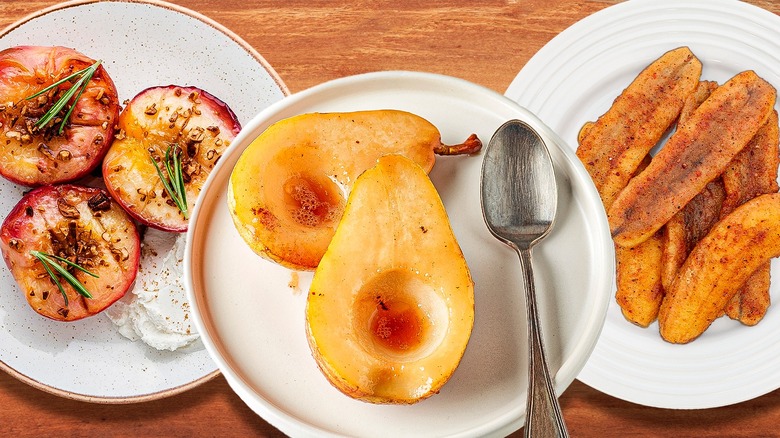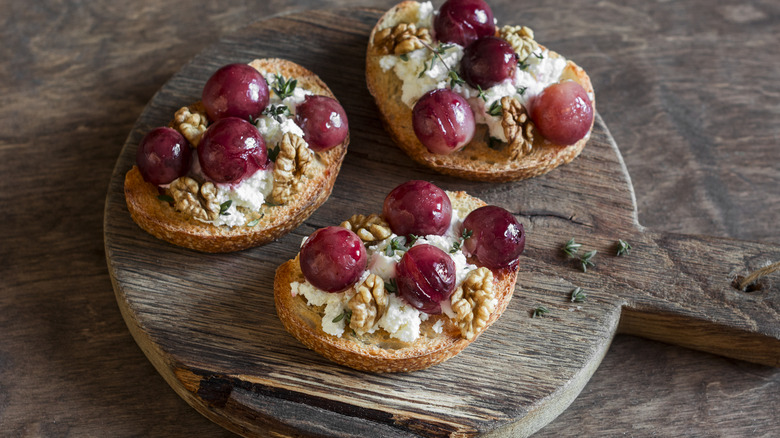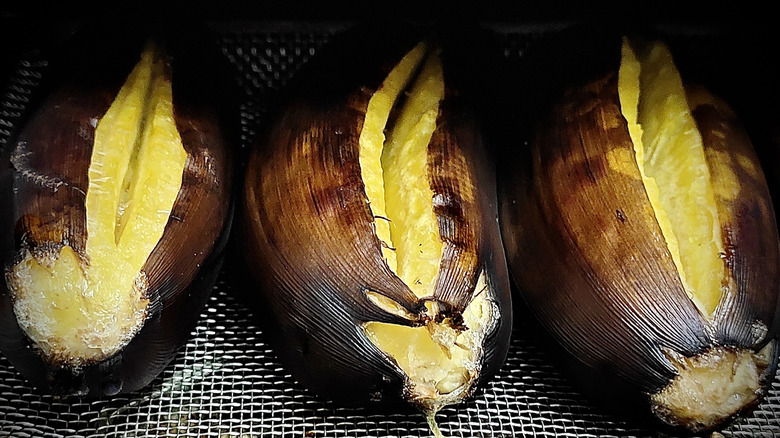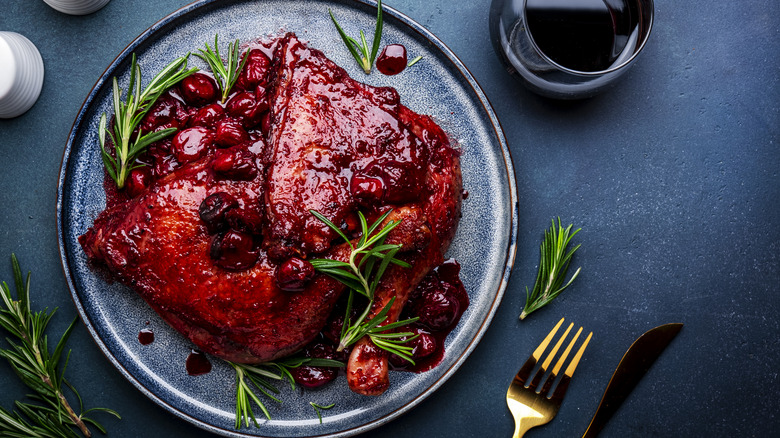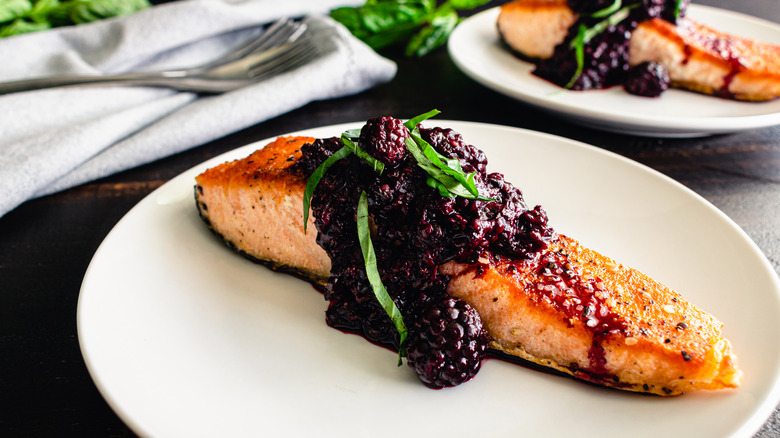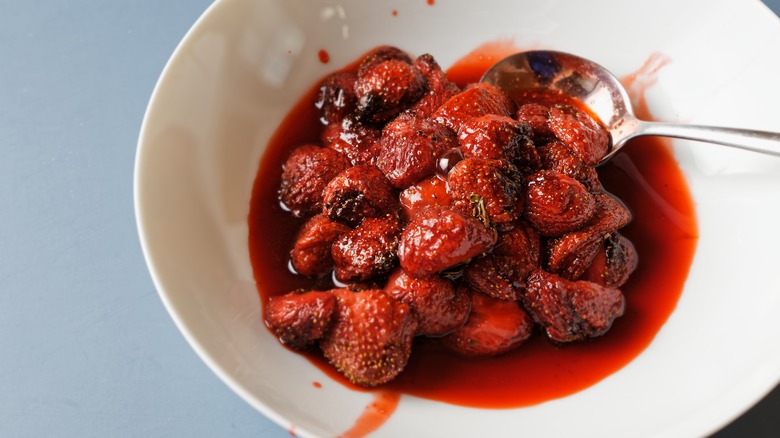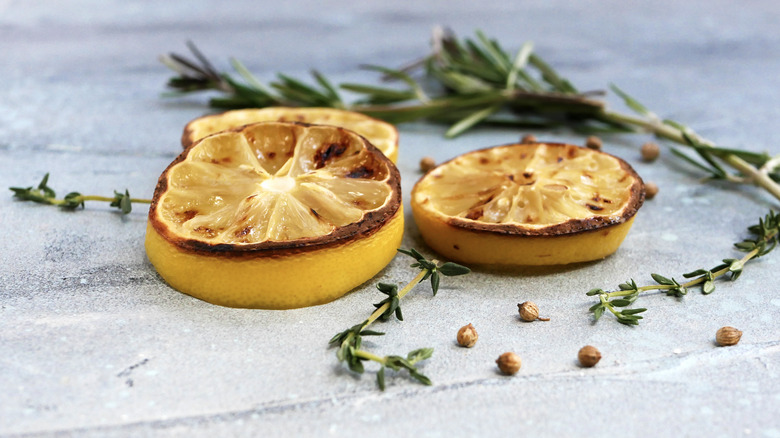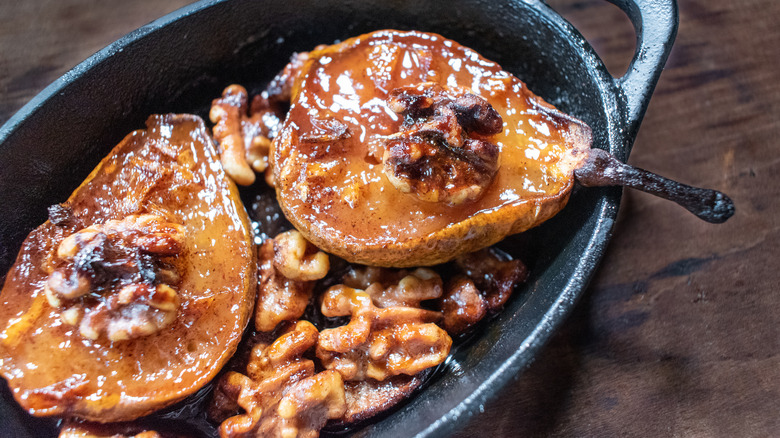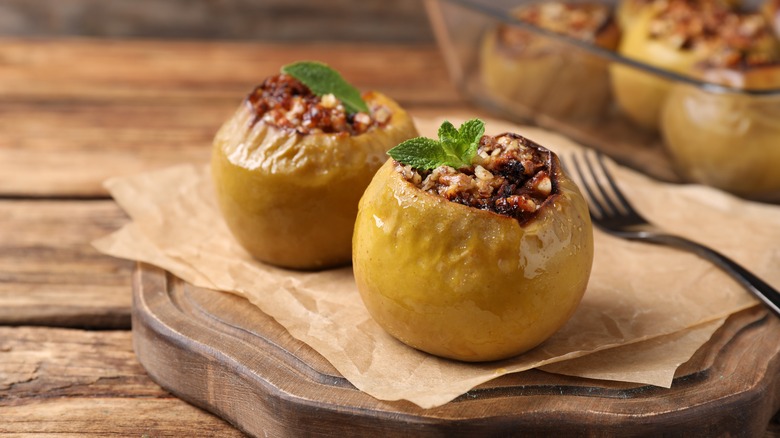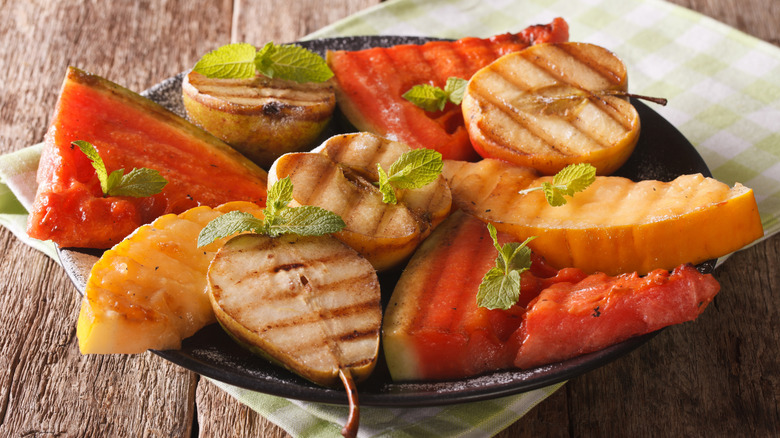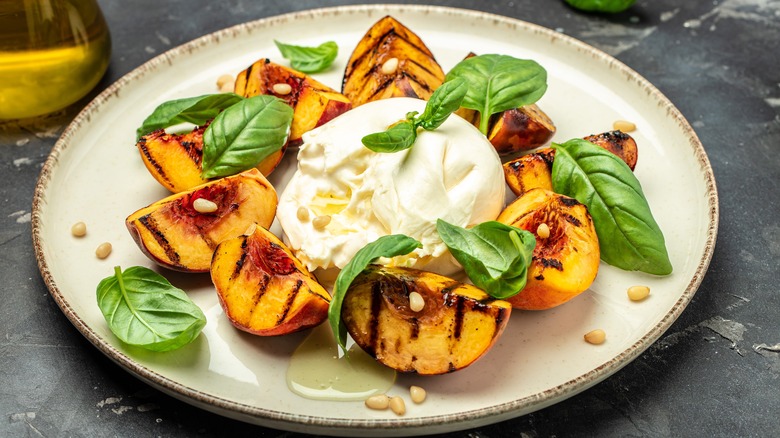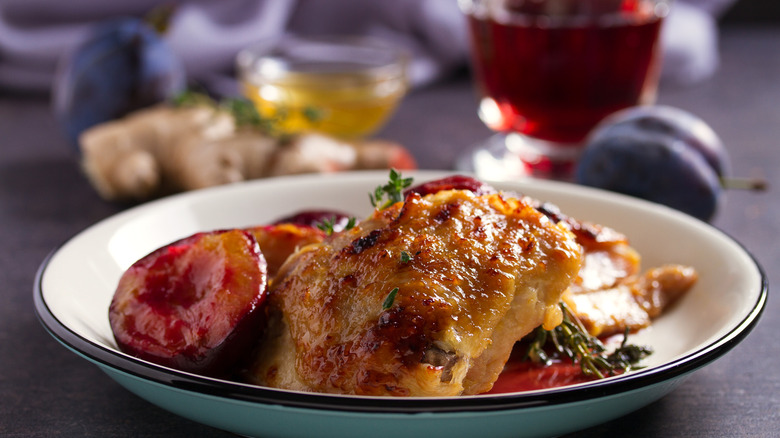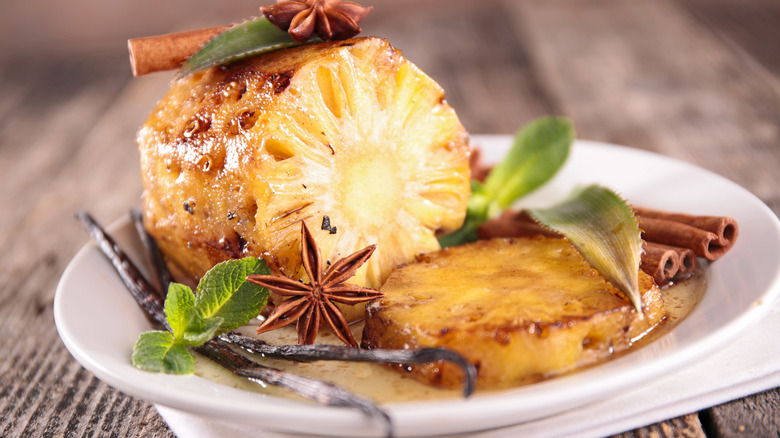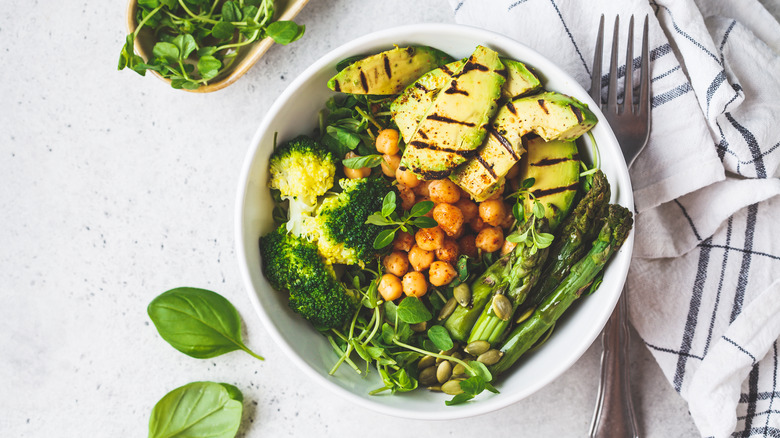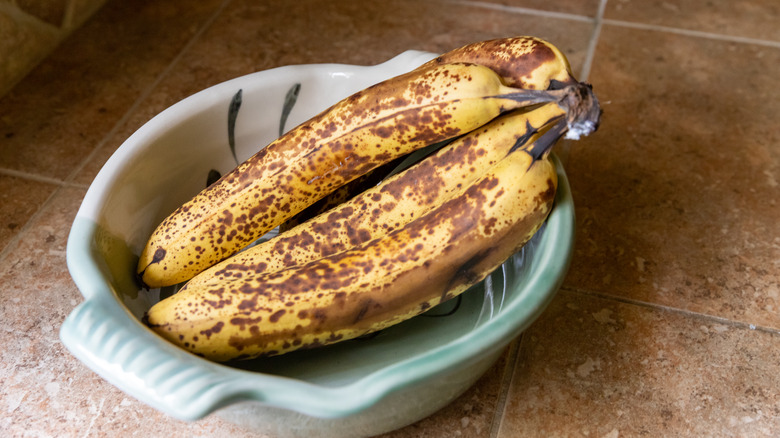14 Fruits You Need To Be Roasting
Learning to make the most of your ingredients is one of the challenging things about cooking and baking, but it's also a lot of the fun. When you can take ordinary ingredients and make them extraordinary, or turn mediocre ingredients into something memorable, it's a real confidence-builder.
Consider fruit. It's already one of the most pleasurable of all ingredients, with its rainbow of bright colors, its many textures, and its combination of sweet and tart flavors. It's fine as it is — especially on those glorious occasions when you can find it fresh-picked and dead ripe — but that doesn't mean it can't be improved, and roasting your fruit is one way to do just that.
Roasting helps break down the tough cell walls, leaving fruit lush and tender, and the heat and caramelization bring out all the subtleties of its flavor (and even create new flavors). Some fruits are better suited to roasting than others, but here are some that are can't-miss options.
1. Grapes
Grapes are one of nature's perfect snacks, bite-sized and full of flavor. They also have a beautiful balance of sweetness and acidity, grounded by a hint of astringency in the skin (that's why they make such great wine).
If you've only ever eaten grapes raw or in raisin form, you're missing out. The simple truth is that grapes love heat, and while their shape and size make them awkward for grilling, they're perfect for roasting. In a hot oven, they'll burst and gently deflate as their juices pool and concentrate on your baking sheet, developing intensely powerful flavors. The skins of dark grapes release their color compounds, giving the flesh and juices a vivid hue; while green grapes develop a milky, jade-like color and their juices turn a honeyed gold.
The obvious place to use roasted grapes is in desserts, where they make a memorable topping for ice cream or angel-food cake, or a colorful layer in a trifle, but don't underestimate them in savory settings. Pair roasted dark grapes with sausage or other rich meats like duck or pork, and we love roasted green grapes with seared chicken breast, a few shreds of fresh basil, and toasted pine nuts.
2. Bananas
Bananas are among the sweetest of all fruits when ripe, and most recipes calling for bananas lean into their sweetness in some way. Picture bananas foster, with its ice cream and rum-based sauce, or banana cream pie with its rich custard and whipped cream.
Roasting bananas is another way to dial up the sweetness. It's also one of the best because you're not adding sugar, you're doubling down on the bananas' own flavor and sweetness; making them even more "banana-y." It couldn't be easier, all you need to do is halve the bananas lengthwise, peel them, and give them a few minutes in a hot oven. They'll soften, and caramelize gently, and give your favorite recipes a real flavor boost.
That banana cream pie will have a bolder flavor if you fill it with roasted bananas. Chunks of roasted banana will elevate your cakes and muffins, and studding your banana pudding with pieces of roasted banana will take it to a whole other level. They're even an easy and memorable upgrade for a homemade banana split.
3. Cherries
All fruits are seasonal by nature but advances in cold storage and fast shipping made it possible to enjoy almost any fruit at any time of the year. There are only a few exceptions, fruits so perishable that even now they're only available for a few brief, precious weeks at a time.
Cherries are one of those fruits. For those of us who love them, it's absolutely mandatory to eat them every way we can while they last. Granted, that usually starts with eating them fresh until we're ready to burst, but once we've had our fill it's time to have fun with them in recipes. Cherry pies and dessert toppings are the usual choices, except for the dedicated foodies spooning cherry-based sauces onto their duck breasts or pairing cherry preserves with strong cheese.
However you choose to use your cherries this year, do yourself a favor and roast some of them. Roasting softens them and concentrates their flavors, creating the ultimate cherry dessert topping. It also makes them super-easy to pit, because you can just squeeze out the stones. Add them to your baked goods, use them to brighten your salads, put them in sauces, or even just freeze them (it's a great way to prep them for storage). You'll be glad you did.
4. Raspberries and blackberries
When you're choosing fruit to roast or grill, one of the usual rules is to stick with sturdy varieties that will hold up under the heat and not fall apart when you handle them. It's a good rule, and it will serve you well, but every rule has exceptions, and you may choose to bend this one occasionally.
Raspberries, blackberries, and their less-common cousins are among those exceptions. Delicate as they are they'll quickly soften in the oven's heat, but that's more or less the point. If you sprinkle them lightly with sugar, and then roast them briefly in a hot oven, the result will be an intense, deeply flavored mixture of berries and slightly thickened juices. It is, in fact, about the lowest-effort way to make a next-level dessert topping.
Spoon it warm or cold over yogurt, ice cream, or cheesecakes, or create instant "sandwich cookies" for the kids by putting it between a couple of plain wafer cookies. If sweets aren't your thing, these roasted berries will make a memorable vinaigrette for your summer salads. You can sieve the seeds out or not, as you choose, but either way the dressing will have a vivid flavor and color.
5. Strawberries
For our grandparents, strawberries were a welcome sign that spring (or early summer, in some regions) was upon us at last. They're now available year-round at supermarkets, though the best berries of all remain the ones you eat fresh from the field when they're at their peak of ripeness.
Those usually come and go within a few weeks, leaving us with supermarket strawberries of variable quality for the remainder of the year. That's okay, because the heat of the oven is a transformative experience for them: Roasting mediocre strawberries makes them good, and it makes good strawberries utterly transcendent.
Roast small berries whole, and slice larger ones into halves or even quarters. After roasting the berries will be fragile, so the easy option is to keep the berries and juices together and use them as a sauce or dessert topping (Best. Shortcake. Ever.). You can also use them separately if you drain the juices from the berries in a colander. If you really want to stretch your wings, use them to make roasted strawberry gelato.
6. Citrus fruits
Citrus fruits are among the most useful and versatile ingredients for cooks and bakers, despite their sometimes mouth-puckering tartness. Their juice, flesh, and zest are all widely used in sweet and savory settings alike, from lemonade and key lime pie to duck a la orange and vinaigrettes.
But here's the thing: Despite their fresh acidity, these fruits have a lot of sugar in them. Grilling or roasting citrus helps bring out that sweetness through caramelization. A hot oven works best (you may even want to use the broiler), and you can roast them halved or in thick slices depending on the recipe you have in mind.
Roasted oranges, limes. or lemons have a deeper flavor and sweet, smoky overtones that work in almost any recipe. Try them in your lemonade or limeade, use the juice and charred peel in vinaigrettes or guacamole, or use them as a flavor-enhancing garnish on meats, fish, and poultry.
7. Pears
Pears' calling card is their lush sweetness, and roasting concentrates and caramelizes that sweetness while giving them a deeper, more complex flavor. Essentially, you're taking them and concentrating their essential "pear-ness" to a point nearing perfection.
Pears come in two broad styles, some with a relatively grainy texture and others buttery and smooth. There are several pears of each type that roast well, including Bosc, Anjou, and Concorde. Unfortunately, we find that some popular pears (looking at you, Bartlett and Comice), are too soft for roasting once they're fully ripe, and will turn to mush before they caramelize (admittedly, it's tasty mush). Choose ripe but firm pears, and roast them in halves or in wedges with or without the skin.
Roasted pears are wonderful in (or with) desserts. Add them to your favorite coffee cakes or muffins, or serve them as a topping with scones or pound cake. A roasted pear on a simple pool of custard, with a few berries for garnish, is an Instagram-worthy dessert. You can stuff the cavity of sturdy pears with nuts, or cheesecake filling, or even with savory spiced meats. Roasted pears and manchego are a great pairing, and so are other bold-flavored cheeses or charcuterie.
8. Apples
Apples are no stranger to the oven ("Mom's apple pie," anyone?), but more often than not they're inside a pastry shell, or diced up in cakes or muffins. Yet roasting apples or crabapples, in nothing more than their own skin, is one of the most traditional ways to prepare them.
The best apples for roasting are firm-textured varieties that will hold their shape as they cook (your favorite pie apples should do just fine). Roasting them and serving them whole is the traditional option, but you don't need to be bound by that. Coring the apples first is perfectly fine, or cutting them into wedges, or you can halve them and scoop out the core with a spoon or a melon baller.
Roasted apples make a fine accompaniment for rich meats (the combination of pork and apple is a classic), or you could stuff them with either sweet or savory fillings if you wish. A whole roasted apple topped with custard or caramel sauce is a fine dessert in itself, or you can pair the hot apple with a scoop of vanilla ice cream and a sprinkle of cinnamon. Pro tip: cinnamon and butter make a fine two-ingredient topping for roasted apples, however you serve them.
9. Melons
Melons may not be the first fruit that springs to your mind when you think about roasting or grilling. That's partly because we tend to enjoy them for their cool, refreshing juiciness — we seldom cook cucumbers either, for the same reason — but that doesn't mean they can't, or won't, benefit from a blast of heat.
This isn't quite the left-field idea it would have seemed just a few years ago because grilling watermelon for salads has become something of a trend. It's fragile and needs to heat quickly, so if you want to use your oven instead of a grill, the broiler is your best choice. Roasting mild-flavored cantaloupes or honeydews is less common, but heat and caramelization work wonders for them, too.
The biggest reason to roast honeydew or cantaloupe is that their flavors will become concentrated as their flesh softens and begins to break down. That's a very useful trick if you want to create an intensely melon-flavored popsicle or paleta, ice cream, smoothie, or sorbet, where the melons' low-key flavors might otherwise be lost.
10. Peaches and nectarines
Is it even summer until you've had that first perfectly ripe peach? You know the one that floods your mouth with sweet, aromatic juices that run down your arm and drip from your elbow.
Peaches and nectarines are the ultimate high-summer fruit, with their thick, sweet, perfumed flesh. They're a delight to eat out of hand, when they're perfectly ripe, and generations of us can attest to how well they work in pies and cobblers. So why mess with a good thing? Because roasting makes them even better, that's why. Roasting softens and caramelizes them, bringing out the fruits' natural sugars (so you'll need to add less to your recipe) and also reduces and concentrates their juices.
Darker-skinned varieties are especially fun to roast because the skins infuse the golden flesh with sunset hues of pink and red that bring a ton of visual appeal to your plate. Put them on leftover biscuits for "instant cobbler," serve them in phyllo as "peach pie pockets" at your next party, or — for a surprising savory twist — serve roasted peaches with prosciutto, or place wedges of roasted peach as a garnish on grilled lamb chops.
11. Plums
Plums come in all shapes and sizes, from grape-sized to baseball-sized, and in varying hues of yellows, greens, reds, and purples. For roasting your best options are the compact Italian-style plums, or any of the large, firm-fleshed varieties.
When roasted, plums represent a middle ground between grapes and peaches. As with peaches roasting emphasizes the juiciness and sweetness of the plums' flesh, leaving it meltingly tender, but — as with grapes — the dark skins also lend the roasted fruit a boldly dark port-wine color. It's a striking effect, however you choose to serve them.
Roasted plums play especially well with roasted or grilled meats, and with either warm or savory spices. They're equally at home in a spicy chutney or a streusel-topped muffin, or even in frozen desserts like a roasted plum semifreddo. For a special treat, line your sheet pan with sweetened shortcrust or your favorite shortbread cookie dough, and roast halved Italian-style plums right on top of the dough. Their juices will soak into the dough, and the result is a treat that will have you coming back for seconds and thirds. It's a firm favorite of ours.
12. Pineapples
Firm-fleshed fruits as a rule are the best for cooking, whether you're roasting or grilling them. One of the best candidates of all is pineapple, which stubbornly holds its shape even in your favorite hours-long slow cooker recipes.
Is there a fruit that takes better to high-heat cooking? Probably not. After all, if it will stand up to the temperature of a commercial pizza oven, you aren't going to hurt it with a few minutes in your home oven. It's really versatile: you can use fresh or canned pineapple, cut it into rings, spears, or wedges, and simply roast it at high heat until it's nicely caramelized. You can even turn down the heat a little, and bake one whole for the sweetest pineapple ever.
Roasted pineapple is sweeter and more aromatic than it is when raw, and the oven's heat also deactivates the meat-tenderizing enzyme in pineapple that irritates your tongue when you eat it raw. Use roasted pineapple in salads and salsas, add it to cakes and muffins, incorporate it into your smoothies and sorbets, or (in short) anywhere you'd use fresh pineapple. Nothing changes, except that it tastes better.
13. Avocados
Like melons, avocados may seem an odd candidate for roasting. They're already soft and creamy, they don't have a lot of sweetness to emphasize, and they certainly don't have any juices to caramelize.
Yet they're often grilled, and there's a good reason for that: A bit of char gives the avocados a hint of smokiness that can elevate your guacamole, your toast, or your salads and wraps, or, in short, anywhere you'd normally use an avocado.
Avocados need quick cooking because they'll basically melt if you leave them in the heat for too long. It's best to roast them under your broiler until they've just begun to char (it only takes a few minutes). You can use them in any recipe calling for grilled avocados, but broiling is a great alternative when the weather isn't suitable for grilling, or when you want to do a big batch and don't have the time to painstakingly grill them.
14. Any fruit that's not at its best
Most of us encounter a lot of disappointments in our lives. They may crop up in our careers or our relationships, or in the sports clubs we choose to cheer for. Aside from those larger disappointments, there are many smaller ones, and, let's face it, one of the small ones we'll encounter most often is disappointing fruit.
Those glossy, perfect specimens at the supermarket were bred to ripen on demand, and to stand up to the rigors of storage and long-distance shipping. They were not, as a rule, bred primarily for flavor. Even the ones that ordinarily taste pretty good may be underripe, or overripe, or develop bruises and soft spots as they sit on our kitchen counters and in our refrigerators' produce drawers.
None of this matters once they're roasted. It's one of our most-used tricks for salvaging substandard fruit, and we taught it frequently in cooking classes. Roasting softens, sweetens, and develops flavor even in hard and underripe fruit; extends the life of overripe fruit and masks its fading texture; and in the case of blemished or misshapen fruit, well... who's to know, once you've roasted it? Roasting turns shaky fruit into a stellar ingredient that yields more flavorful sorbets, baked goods, and sauces, and that's a solid win.
